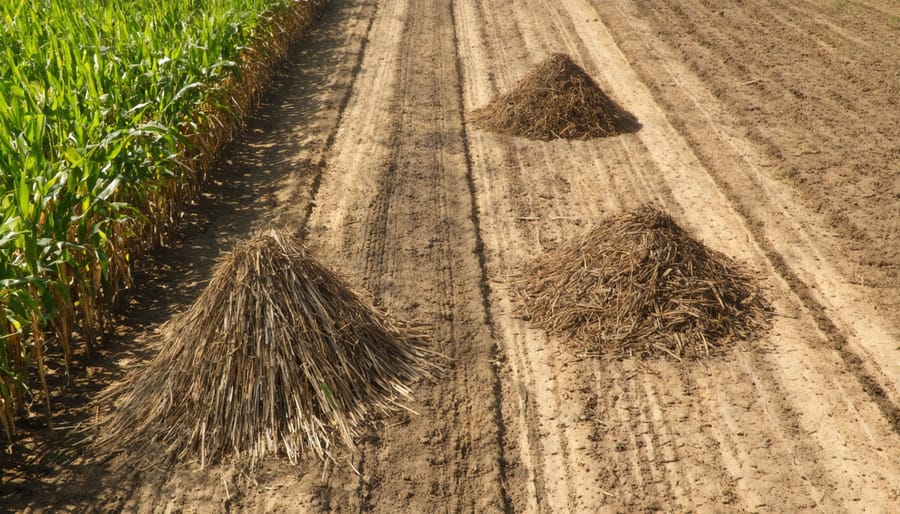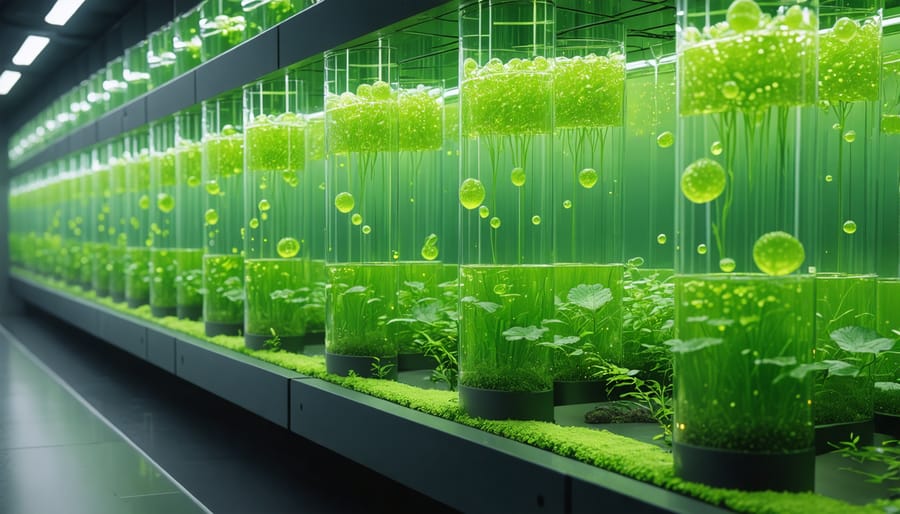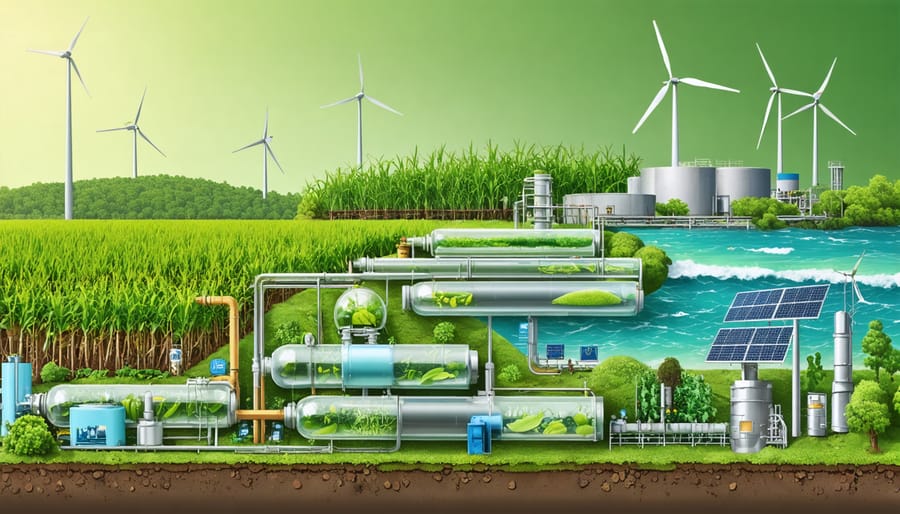Transforming everyday organic materials into tomorrow’s fuel sources stands at the forefront of Australia’s evolving renewable energy landscape. From agricultural waste to purpose-grown crops, feedstocks for biofuels represent a critical bridge between our fossil fuel-dependent present and a sustainable energy future.
The humble beginnings of sugarcane waste and corn stalks have given way to sophisticated biomass sources, including algae farms and dedicated energy crops that promise higher yields with smaller environmental footprints. These next-generation feedstocks are revolutionizing how we think about renewable fuel production, offering solutions that don’t compete with food resources or require extensive land use changes.
As global energy demands surge and climate challenges intensify, Australian farmers and energy producers are pioneering innovative approaches to feedstock cultivation. Their efforts are creating new revenue streams for agricultural communities while helping to decarbonize our transport sector. The transformation of waste materials into valuable fuel sources not only addresses our energy needs but also provides a practical solution to waste management challenges, creating a circular economy model that benefits both the environment and local communities.
Agricultural Waste: Australia’s Hidden Biofuel Goldmine
Sugarcane Bagasse: Sweet Success in Queensland
Queensland’s sugar industry has transformed what was once considered waste into a valuable renewable resource. Through innovative sugarcane waste utilization, the bagasse – fibrous material left after crushing sugarcane – now powers both sugar mills and local communities.
The Racecourse Mill in Mackay stands as a shining example of this sustainable practice. By processing bagasse, the facility generates enough electricity to power its operations and feeds surplus energy into the local grid, providing clean power to thousands of homes. This dual-purpose approach has turned a traditional agricultural by-product into a significant revenue stream while reducing greenhouse gas emissions.
Several other Queensland mills have followed suit, creating a network of biopower facilities that collectively produce over 850 GWh of renewable electricity annually. This success has caught the attention of international investors and environmental experts, who view Queensland’s bagasse-to-energy model as a blueprint for sustainable agriculture.
The benefits extend beyond energy production. Farmers report improved soil health from returning ash residues to their fields, while local communities enjoy cleaner air compared to traditional burning practices. With Queensland producing around 30 million tonnes of sugarcane annually, the potential for expanding bagasse-based bioenergy continues to grow, promising a sweeter future for both the industry and the environment.

Wheat Straw and Corn Stover: Grain Belt Giants
The vast grain-producing regions across Australia’s wheat belt and similar agricultural areas worldwide offer an abundant and sustainable source of biofuel feedstock through crop residues. Wheat straw and corn stover – the leaves, stalks, and cobs left after grain harvest – represent a massive untapped resource that’s already being produced as a by-product of food production.
In Australia’s wheat belt, stretching from Western Australia through New South Wales, farmers typically produce millions of tonnes of wheat straw annually. Rather than burning these residues or leaving them to decompose, innovative collection and processing systems are now enabling their conversion into valuable biofuels.
These agricultural giants offer several advantages as feedstock sources. They’re readily available, require no additional land use, and their collection can provide farmers with supplementary income streams. Modern harvesting techniques allow for selective residue collection, ensuring enough organic matter remains in the soil to maintain health and prevent erosion.
The sugar and starch components in these materials can be converted into bioethanol through various processes, while the lignin content offers potential for advanced biofuel production. Leading grain-producing regions are already demonstrating success, with some facilities processing thousands of tonnes of straw annually into biofuel.
For Australian farmers, this represents a brilliant opportunity to boost farm income while contributing to renewable energy production, creating a true win-win situation for agriculture and sustainability.
Energy Crops: Purpose-Grown Power
Native Species Leading the Charge
Australia’s unique biodiversity offers exceptional opportunities for biofuel production, with several Australian native plants showing remarkable potential as sustainable feedstocks. Leading the charge is Mallee eucalyptus, a hardy species that thrives in marginal agricultural lands while producing oil-rich biomass. These trees not only provide excellent feedstock but also help combat soil salinity and erosion, offering multiple benefits to farmers.
Another promising contender is the native grass species Triodia, commonly known as spinifex. This drought-resistant plant produces high amounts of biomass and can grow in arid conditions where traditional crops struggle. Its natural adaptations to harsh environments make it an ideal candidate for large-scale cultivation without competing with food production.
The coastal beauty Banksia is emerging as an unexpected hero in the biofuel landscape. Its woody fruits contain high energy content, and the plant’s ability to thrive in poor soils makes it an attractive option for degraded land rehabilitation projects that double as biofuel farms.
Native legumes like Acacia saligna are also gaining attention. These nitrogen-fixing plants improve soil quality while producing seeds rich in oils suitable for biodiesel production. Their rapid growth rate and minimal maintenance requirements make them particularly appealing for commercial cultivation.
These indigenous species offer distinct advantages over introduced crops: they’re naturally adapted to Australian conditions, require minimal irrigation, and support local biodiversity. Their development as biofuel feedstocks represents a uniquely Australian solution to sustainable energy production, combining environmental benefits with economic opportunities.
Fast-Growing Giants: Bamboo and Hybrid Species
In the quest for efficient biofuel feedstocks, fast-growing giants like bamboo and hybrid species have emerged as game-changers in Australia’s renewable energy landscape. Bamboo, particularly the species Bambusa oldhamii, has captured attention for its remarkable growth rate of up to 30 centimetres per day under optimal conditions, making it a potential powerhouse for biomass production.
These towering grass species offer several advantages over traditional feedstocks. Their extensive root systems help prevent soil erosion, while their ability to thrive on marginal lands means they don’t compete with food crops for prime agricultural space. In Queensland’s tropical regions, bamboo plantations are already being trialled as sustainable biomass sources, with early results showing promising yields of up to 40 tonnes per hectare annually.
Hybrid species, particularly engineered varieties of fast-growing trees like eucalyptus and poplar, are also making waves in the biofuel sector. These “super trees” combine rapid growth with enhanced biomass production, often reaching harvest maturity in half the time of their native counterparts. The CSIRO has developed several hybrid varieties specifically adapted to Australian conditions, capable of producing significant biomass while being more resistant to pests and diseases.
What makes these giants particularly attractive is their minimal maintenance requirements once established. They’re true “plant and forget” options, requiring less water and fewer inputs than many traditional crops, while providing a consistent, renewable source of biomass for years to come.

Algae: The Next-Gen Feedstock
Coastal Opportunities
Australia’s vast coastline presents an extraordinary opportunity for marine-based algae cultivation, offering a promising avenue for sustainable biofuel production. With over 35,000 kilometres of coastline, our nation is perfectly positioned to harness the potential of marine algae as a renewable feedstock.
Coastal algae farms require minimal freshwater and don’t compete with food crops for arable land, making them an environmentally conscious choice. These aquatic powerhouses can produce up to 30 times more oil per hectare than traditional land-based crops, while simultaneously acting as carbon sinks and helping to clean our oceans.
Several pilot projects along the Queensland and Western Australian coasts have demonstrated the viability of large-scale algae cultivation. These initiatives use innovative floating systems that take advantage of natural ocean currents and sunlight, significantly reducing operational costs.
The beauty of marine algae lies in its rapid growth cycle – some species can double their biomass in as little as 24 hours. This quick turnaround, combined with Australia’s abundant sunshine and clean coastal waters, creates ideal conditions for year-round production.
Looking ahead, coastal algae farms could become a cornerstone of Australia’s renewable energy landscape, providing both environmental benefits and new economic opportunities for coastal communities.
Desert Potential
Australia’s vast inland regions present a unique opportunity for algae-based biofuel production. The abundant sunlight, available land, and presence of saline groundwater create ideal conditions for establishing large-scale algae farms in our arid zones. These desert-based operations can transform seemingly unproductive land into green energy powerhouses.
Several pilot projects in central Australia have demonstrated promising results, with some strains of algae thriving in the harsh desert conditions. These hardy organisms can produce up to 30 times more oil per hectare than traditional oil crops while requiring minimal freshwater resources. The use of saline aquifers for cultivation means these operations don’t compete with agricultural water needs.
Desert algae farms also offer additional benefits beyond biofuel production. They can help rehabilitate degraded land, create employment opportunities in remote areas, and potentially support carbon capture initiatives. Some innovative farmers are already exploring integrated systems where algae production complements existing pastoral activities.
The technology for desert-based algae cultivation continues to improve, with new breakthroughs in strain selection and harvesting methods making these operations increasingly viable. As Australia seeks to diversify its renewable energy portfolio, our inland regions could become the backbone of a thriving biofuel industry.
Urban Waste: Tomorrow’s Fuel Source
Food Waste to Fuel
The transformation of food waste into biofuel represents one of Australia’s most promising opportunities in the renewable energy sector. From cafes to commercial kitchens, food processing facilities to supermarket waste, these materials once destined for landfills are now powering a sustainable energy revolution.
Leading the charge is a groundbreaking facility in Melbourne that converts used cooking oil from local restaurants into biodiesel, producing over 50 million litres annually. This initiative not only reduces waste but also creates a cleaner-burning fuel that’s helping local transport companies slash their carbon emissions.
But it’s not just cooking oil making waves. Innovative processing techniques are turning fruit pulp, vegetable scraps, and even coffee grounds into valuable biofuel feedstock. The City of Sydney’s food waste collection program, for example, diverts tonnes of organic waste from restaurants to biodigesters, where it’s converted into biogas for power generation.
Food manufacturers are also jumping on board, with several major Australian companies now converting their production waste into biofuel. A prominent dairy processor in Victoria has implemented a system that transforms whey, a cheese-making byproduct, into bioethanol, demonstrating how waste from one process can become valuable fuel for another.
This waste-to-fuel approach offers a dual benefit: reducing the environmental impact of food waste while creating renewable energy. For businesses, it’s a win-win solution that turns a disposal cost into a valuable resource.

Green Waste Revolution
Australia’s cities and towns are sitting on a goldmine of green potential, with municipal green waste emerging as a game-changing feedstock for biofuel production. From lawn clippings and fallen leaves to pruned branches and garden trimmings, these organic materials – once destined for landfills – are now powering a sustainable energy revolution.
Local councils across the country are transforming their waste management approaches, with many implementing sophisticated collection and sorting systems. The City of Newcastle, for instance, has pioneered a innovative program that converts over 12,000 tonnes of green waste annually into valuable biofuel feedstock, demonstrating the immense potential of urban organic waste.
What makes municipal green waste particularly attractive is its steady availability throughout the year and its concentrated collection points in urban areas. This reliability factor, combined with existing collection infrastructure, makes it a cost-effective feedstock option. Advanced processing facilities are now capable of converting this urban biomass into various biofuel products, from biogas for local power generation to liquid biofuels for transport.
The benefits extend beyond energy production. By diverting green waste from landfills, councils are reducing methane emissions, creating local jobs, and generating revenue from what was once considered a disposal expense. Forward-thinking municipalities are also integrating green waste processing into their circular economy initiatives, creating sustainable loops where waste becomes a valuable resource.
Australia stands at the threshold of a transformative energy future, with diverse feedstock sources offering promising pathways to sustainable biofuel production. The rich tapestry of available biomass resources – from agricultural residues to innovative algal cultivation – positions our nation uniquely to become a leader in renewable energy production.
Our agricultural sector’s waste streams, including sugar cane bagasse and wheat straw, provide immediate opportunities for biofuel development while supporting rural communities. Meanwhile, emerging technologies in algae cultivation and purpose-grown energy crops demonstrate how innovation can expand our feedstock options without competing with food production.
The strategic development of these varied feedstock sources could deliver multiple benefits: reducing greenhouse gas emissions, creating new revenue streams for farmers, and strengthening energy security across the continent. By embracing a mixed feedstock approach, we can build resilience into our biofuel production systems and adapt to changing environmental conditions.
Looking ahead, Australia’s vast landmass and diverse climate zones offer unprecedented opportunities for scaling up sustainable feedstock production. With continued investment in research and development, supportive policy frameworks, and industry collaboration, we can create a robust biofuel sector that serves as a model for other nations.
The journey toward a sustainable energy future through biofuels is not just about replacing fossil fuels – it’s about reimagining our relationship with waste, agriculture, and energy production. By harnessing our natural advantages and innovative spirit, Australia can lead the way in demonstrating how diverse feedstock sources can power a cleaner, more sustainable tomorrow.

